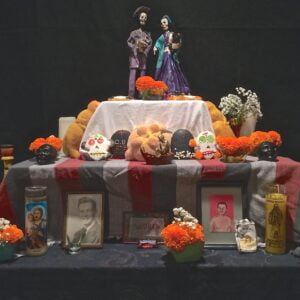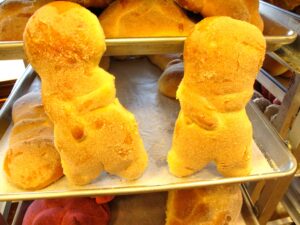
Bread of the Dead (Natural History Magazine, November 1998)
Francisco Marquez and I are sitting at the farmhouse table, drinking hot chocolate and eating sweet pan de muerto, the bread of the dead. It is the morning of November first, Dia de los Muertos, the Day of the Dead. As we talk, just beyond the dining room’s open-air doorway, three baby turkeys peck at the bare dirt in the courtyard. Several radios are playing in other parts of the village, and boys are yelling down by the river. But by far the loudest sound is the frantic mooing of cattle. “They want to eat too,” Francisco chuckles.
His wife, Margarita, shows me the kitchen. It is in a shed made of sticks fastened together vertically, so the light on the dirt floor is striped. Mole negro, the deep black sauce which is traditional on Dia de los Muertos, is cooking in a cazuela, a clay pot that sits directly in the coals of the wood fire. Two dead chickens are lying on the dirt floor waiting to be plucked. “Chickens to eat with the mole,” Margarita explains. In the poorest houses, the mole negro is eaten in a bowl like a soup. To have chicken with the mole is a luxury.
In bags throughout the house, there are many more loaves of pan de muerto. I ask how many loaves of bread the family bought. The week before Dia de los Muertos, she says, it is the custom for the family to buy a ten-kilo sack of flour and take it to the baker along with five dozen eggs and the other ingredients needed for the sweet egg bread. Most families also bring along the papier-maché decorations that are inserted into each loaf. The papier-maché ovals have little faces painted on them; when the pan de muerto is finished, each loaf of bread represents an individual soul. The baker prepares the family’s entire order of pan de muerto at one time. The ten-pound sack of flour yielded 130 loaves this year, including the tiny loaves for the angelitos.

“The angelitos are here now,” says Francisco, as he shows me the family ofrenda which dominates an entire wall of the living room. There are tiny cups of hot chocolate and little loaves of bread on the altar. Angelitos are the souls of dead infants, including the souls of miscarried and stillborn children.
“Has your family lost many children?” I ask.
“No, not so many,” he says. “But that’s not important. Some of the spirits don’t have families to go to, so we have to put out food and drinks for all of them.”
The ofrenda is the center of the Day of the Dead celebration. It is an altar that is generally built of three tiers, each smaller than the one beneath it, like a pyramid. The tiers are covered in cloth, and an arch of sugar cane stalks is formed above the altar. It is decorated with the marigold-like flower known as zempoalxochitl (“flower of the dead” in the Nahuatl language).
On the top tier, there are often photos of deceased friends and relatives or religious statues and candles. Most of the rest of the altar space is covered with special foods and beverages, especially pan de muerto, fruits, and hot chocolate.
“The angelitos will leave at noon, and then we will put out the food and drinks for the adult spirits,” Francisco says. I am not wearing a watch, and neither is Francisco. I look around the house, but I don’t see any clocks. I wonder how he can be so precise about the timing.
It is very warm indoors, so Francisco and I go outside and sit on a porch facing the courtyard. An old woman walks by carrying a bundle of firewood, which she drops outside the kitchen before she enters. “That is my mother,” Francisco says. Her name is Vincenta, she is 76, and she has the classic hawk nose and high cheekbones of a full-blooded Zapotec.
Suddenly, the church bells begin ringing and fireworks explode all over the village. A parrot in a cage hanging from the eaves above us begins to shriek. I marvel at how perfectly the village is synchronized. There is never any doubt about when it is precisely noon on November first in the village of San Lorenzo Cacaotepec.
Francisco looks squarely into my eyes. “The angelitos are leaving now,” he says with a quiet smile. Vincenta and Margarito come out of the kitchen carrying a bowl of black mole, a bottle of mescal and glasses and some pan de muerto, which they take into the living room to place on the ofrenda. Francisco and I go watch.
“My father was born here on this farm 85 years ago,” says Francisco. Crispin Marquez worked so hard that people called him El Machin, “the machine.” As soon as Francisco was born, people called him El Machin Chico, “the little machine.”
Francisco says that he has no photo of his father to mark his altar. But because El Machin loved mescal and mole negro, every year the family gives him those things. El Machin Chico pours El Machin Viejo a hefty shot of mescal and places it on the ofrenda. .
Francisco leads me back to the porch and insists that I join him in a shot of mescal. I understand that I am not just joining El Machin Chico in this mescal, I am also joining El Machin Senior, and to refuse would be an insult. I can also see that by this logic I could become very drunk, very quickly. After a few, I say my good byes and head off for the village center.
The farm and the countryside are lush and green. By comparison, the village, with its rutted roads and open sewers, is not much to look at, but I spend the rest of the day there gladly. I visit ofrendas, give and receive loaves of bread, and eat and drink with the people of the village and all their dead friends and relatives.
I am surprised to see a Dia de los Muertos ofrenda in the village church. I grew up a Catholic, and I was aware that November First, All Saints’ Day, formerly known as Allhallows, had inspired Halloween, or Allhallows Eve. But Halloween is far from an official Christian holiday. In my community some fundamentalist Christians have complained that Halloween decorations should be banned from public schools. And yet here in Oaxaca, Dia de los Muertos is perhaps the most important Catholic holiday of the year.
As it happened, Davíd Carrasco, a professor of Comparative Religion at Princeton, was in Oaxaca for Day of the Dead. I called him at his hotel and we discussed the ofrendas we had seen that day. Carrasco was particularly interested in the similarity between the modern ofrenda and the ancient ceremonial pyramids of Mesoamerica, which were also heaped with fruits and flowers. The holiday predates Catholicism’s arrival in Mexico, Carrasco has written, but Catholicism cleverly expanded to include it.
I talked to several other trained observers about the ideas behind Day of the Dead, such as the belief that your life on this earth depends on treating the dead well, and that if the dead are not properly worshiped, your own economic security and health could be jeopardized. I heard about villages where people spend all night in the graveyard to welcome the dead back, and I heard about fear of the vengeful ignored dead and of angry spirits with no homes to go to.
In Dia de los Muertos, you can find layers upon layers of meaning stretching back into prehistory. But after spending the day with El Machin Chico and his family, I came to a very simple understanding of the holiday. Dia do los Muertos is a time for the living to join their dead family and friends in a joyful feast.
That night, I had a dream in which I saw the face of a crying baby. I woke up and thought of my first and only son, who was stillborn. At the suggestion of the grief counselor at the hospital, my ex-wife and I gave the child a name: Andrew, after my grandfather. We had a brief memorial service, and for a few years we lit a candle on his birthday. But since the birth of my two daughters, I had rarely thought of him.
But this year, I plan to celebrate the Day of the Dead. My ofrenda will have an old black-and-white picture of my dad and a sonogram of Andrew on the top tier. Underneath that, I’ll put out a glass of Scotch and a ham-salad sandwich for Dad and a tiny cup of hot chocolate and a sweet bun for Andrew. Then, on November first, all three generations of us will sit down and enjoy a meal together.
The Bread of the Dead
AUTHOR: Walsh, Robb
PUB. DATE November 1998
SOURCE Natural History; Nov98, Vol. 107 Issue 9, p66
SOURCE TYPE: Periodical
DOC. TYPE:Article